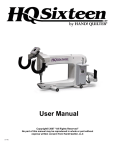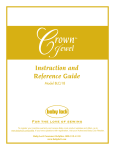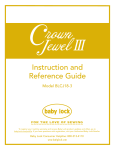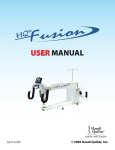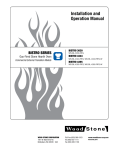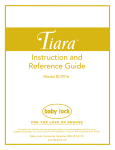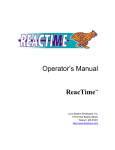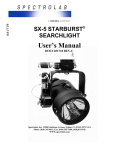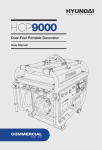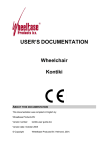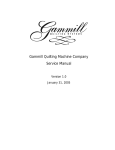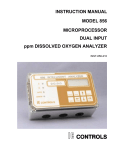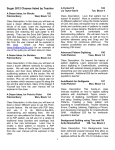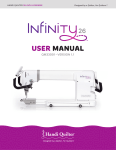Download Jewel (BLJ18) Manual
Transcript
Baby Lock Jewel Contents Baby Lock Jewel Quick Facts . . . . . . . . . . . . . . . . . . . . . . . . . . . . . . . . . . . . . . . . . . . . . 2 Baby Lock Jewel Disclaimer. . . . . . . . . . . . . . . . . . . . . . . . . . . . . . . . . . . . . . . . . . . . . . 2 Home Machine Quilting Frame Recommendation. . . . . . . . . . . . . . . . . . . . . . . . . . . 3 Baby Lock Jewel Safety Section. . . . . . . . . . . . . . . . . . . . . . . . . . . . . . . . . . . . . . . . . . . 3 Package Contents/Included Accessories. . . . . . . . . . . . . . . . . . . . . . . . . . . . . . . . . . . . 4 Baby Lock Jewel Components Front-Side Diagram A. . . . . . . . . . . . . . . . . . . . . . . . . . . . . . . . . . . . . . . . . . . . . . . . . 5 Back-Side Diagram B. . . . . . . . . . . . . . . . . . . . . . . . . . . . . . . . . . . . . . . . . . . . . . . . . 6 Rear Diagram C. . . . . . . . . . . . . . . . . . . . . . . . . . . . . . . . . . . . . . . . . . . . . . . . . . . . . . 6 Installing Machine on Carriage. . . . . . . . . . . . . . . . . . . . . . . . . . . . . . . . . . . . . . . . . . . 7 Installing Front Handles. . . . . . . . . . . . . . . . . . . . . . . . . . . . . . . . . . . . . . . . . . . . . . . . . 8 Installing Rear Handles . . . . . . . . . . . . . . . . . . . . . . . . . . . . . . . . . . . . . . . . . . . . . . . . . 9 Cluster LED Pin Light Installation and/or Replacement. . . . . . . . . . . . . . . . . . . . . . . 9 Inserting (or Changing) the Needle/Needle Guide. . . . . . . . . . . . . . . . . . . . . . . . . . 10 Installing the Power Cord. . . . . . . . . . . . . . . . . . . . . . . . . . . . . . . . . . . . . . . . . . . . . . . 11 Installing the Thread Mast. . . . . . . . . . . . . . . . . . . . . . . . . . . . . . . . . . . . . . . . . . . . . . 11 Laser Stylus Safety and Use Guidelines . . . . . . . . . . . . . . . . . . . . . . . . . . . . . . . . . . . 12 Installing the Laser Stylus. . . . . . . . . . . . . . . . . . . . . . . . . . . . . . . . . . . . . . . . . . . . . . 13 Threading the Machine . . . . . . . . . . . . . . . . . . . . . . . . . . . . . . . . . . . . . . . . . . . . . . . . 14 Bobbin and Thread Tension Adjustments. . . . . . . . . . . . . . . . . . . . . . . . . . . . . . . . . . 16 Maintenance. . . . . . . . . . . . . . . . . . . . . . . . . . . . . . . . . . . . . . . . . . . . . . . . . . . . . . . . . 17 Using the Displays on the Handles. . . . . . . . . . . . . . . . . . . . . . . . . . . . . . . . . . . . . . . 18 Using the Handle Buttons . . . . . . . . . . . . . . . . . . . . . . . . . . . . . . . . . . . . . . . . . . . . . . 20 Baby Lock Jewel Regulator Setup. . . . . . . . . . . . . . . . . . . . . . . . . . . . . . . . . . . . . . . . 20 To Begin Quilting. . . . . . . . . . . . . . . . . . . . . . . . . . . . . . . . . . . . . . . . . . . . . . . . . . . . . . 21 Troubleshooting . . . . . . . . . . . . . . . . . . . . . . . . . . . . . . . . . . . . . . . . . . . . . . . . . . . . . . 22 Variable Speed Bobbin Winder. . . . . . . . . . . . . . . . . . . . . . . . . . . . . . . . . . . . . . . . . . 27 Bobbin Winder Instructions. . . . . . . . . . . . . . . . . . . . . . . . . . . . . . . . . . . . . . . . . . . . . 28 Optional Accessories Channel Lock. . . . . . . . . . . . . . . . . . . . . . . . . . . . . . . . . . . . . . . . . . . . . . . . . . . . . . . 30 Ruler Base. . . . . . . . . . . . . . . . . . . . . . . . . . . . . . . . . . . . . . . . . . . . . . . . . . . . . . . . . 30 Stylus and Adaptor Plate with Holder. . . . . . . . . . . . . . . . . . . . . . . . . . . . . . . . . . 31 Horizontal Spool Pin. . . . . . . . . . . . . . . . . . . . . . . . . . . . . . . . . . . . . . . . . . . . . . . . . 32 1 Baby Lock Jewel Quick Facts Sewing Speed Approximately 1,500 spm Minimum Sewing Speed 150 spm Needle Bar Stroke 35.3 mm Sewing Foot Stroke/Lift 5 mm Needle System 135x7 Standard Needle Sizes 14/90 – 20/120 Lubricating Oil & Greases Kluber Lubrication Dimensions of Sewing Machine Throat 8.25˝ x 18.00˝ Rate Voltage/ Power Consumption 120 volts, 60 Hz 120 watts Power Consumption of LED Lights 10 watts Hook System Custom Manufactured, Rotary, Large Bobbin Bobbin Type Class M Motor Type Brushless DC, Internal Encoding Automatic Needle Positioning Up and down, full stitch and half stitch Cluster Lights 36 LED lights 2 Baby Lock Jewel Disclaimer Baby Lock and its authorized retailers are not legally responsible or liable for damage to the Baby Lock Jewel when used improperly or not in accordance with the guidelines stated in this manual or when used on Home Machine Quilting Frames not recommended by Baby Lock. For additional product information, visit our website at: www.babylock.com. Home Machine Quilting Frame Recommendation • Grace Pinnacle Frame Baby Lock Jewel Safety Section NOTE: Do not operate your Baby Lock Jewel quilting machine until you have completely read the information contained in this manual. Please keep all packaging and order information for warranty purposes. 1. Always unplug the Baby Lock Jewel from the electric outlet when performing any maintenance, changing the needle, removing thread locks, or when left unattended. 2. Keep fingers away from all moving parts. Use caution around the needle or sharp external components. 3. Change the needle often. Do not use bent or dull needles. 4. Switch the power off when making any adjustments in the needle or bobbin area, such as threading the needle, installing the bobbin case, oiling or when cleaning. 5. Never drop or insert foreign objects into any opening. 6. The Baby Lock Jewel should only be used indoors away from moisture. 7. The Baby Lock Jewel should not be stored or used in extreme temperatures. 8. Use the Baby Lock Jewel only for its intended use as described in this manual. 9. Use only attachments recommended by the manufacturer in this manual. 10. To disconnect from the wall outlet, push the switch to the off position, then remove the plug from outlet pulling from the plug, not the cord. Never operate the Baby Lock Jewel if the cord is damaged in any way. If a mechanical or electrical problem is encountered, please consult local authorized Baby Lock retailer. 3 Package Contents /Included Accessories Part Name Part Code Box 1 of 3 Baby Lock Jewel Quilting Machine / Stitch Regulator BLJ18 Machine Carriage JW009518 User Manual IBBLJ18 Bobbins (5 pieces) BLJ-BOB (3 pkg.) Needle size 16 (1 pkg. of 10) 134FG-100 Needle size 18 (1 pkg. of 10) 134FG-110 Bobbin Case JW000586 Thread Mast JW010214 Oiler JW010272 Power Cord JW020277 Hex Wrench for Needle Clamp JW010286 Hex Wrench for Handles JW010289 Laser Stylus and Clamp JW020259 Laser Stylus Post JW010290 Box 2 of 3 Front Handles JW029418 Photo 5 shown on page 8 Rear Handles JW029388 Photo 6 shown on page 9 JW029307 Photo 1 shown on page 27 Box 3 of 3 Variable-Speed Bobbin Winder Optional Accessories Adaptor Plate/Stylus Holder BLJ18-SA Shown on page 31 Channel Lock BLJ18-CL Shown on page 30 Cluster Lights (pkg. 2) BLJ18-L Shown on page 9 Horizontal Spool Pin BLJ18-HS Shown on page 32 Needle size 20 (1 pkg. of 10) 134FG-125 Shown on page 4 Quilt Pattern Boards Various Not shown Ruler Base BLJ18-RB Shown on page 30 Stylus BLJ18-ST Shown on page 31 4 Baby Lock Jewel Components Front-Side Diagram A 1. Thread Mast 8. Thread Guide E 2. Thread Guide A 9. Needle Bar Thread Guide 3. Three Hole Thread Guide B 10. Needle 4. Thread Guide C 11. Front Casing/Frame 5. Tension Assembly 12. Hand Wheel 6. “Stirrup” Thread Guide D 13. Side Laser Stylus Post Hole 7. Take Up Lever 5 Baby Lock Jewel Components continued Back-Side Diagram B 14. Machine Stitch Regulator 15. Hopping Foot 16. Needle Bar 17. Presser Bar 18. Back Casing/Frame 19. Front Handle Serial Port Connector 20. Top Laser Stylus Post Hole 21. Front Threaded Handle Holes 22. Bobbin Assembly 23. Needle Plate 24. Front Base Plate 25. Oval Position Guides 26. Rear Base Plate 27. Wheels (4) Rear Diagram C 28. Spool Pin 1 29. Laser Stylus Power Connector 30. Front Electronic Control Cover 31. Serial Port for Stitch Regulator 32. Rear Handle Serial Port 33. Rear Threaded Handle Holes 34. Power Cord Connector 35. On/Off Switch 36. Back Power Cover 37. Spool Pin 2 6 Installing Machine on Carriage 1. Place the carriage on the table rails ensuring that the carriage stitch regulator assembly is toward the front of the table (Photo 1). 2. The stitch regulator, machine and carriage are connected by a Front of table ribbon cable that has 3 connectors (Photo 2). The machine should arrive from the factory with the ribbon cable already attached by Connectors A and B. The remaining end, Connector C, will be connected in Step 4. Carriage Stitch Regulator Assembly NOTE: Connector A is a serial port connector and connects at position 31 as seen in (Rear Diagram C, #31 on page 6). Connector B connects to the machine stitch regulator assembly shown in (Back-Side Diagram B, #14 on page 6), as well as (Photo 3). If these two connections have come loose in shipping, reconnect them before proceeding to step 3. 3. Place the machine on the carriage, with the front of the machine toward the front of the table and all wheels on the carriage rails. Back of table 4. Plug final ribbon cable Connector C into the carriage stitch regulator assembly (Photo 1). Photo 1 B C Photo 2 A Photo 3 7 Installing Front Handles CAUTION: Unplug the Baby Lock Jewel from the electrical outlet. All power to the machine must be turned off when installing the front handles. Failure to do so can result in damage to the machine. IMPORTANT NOTE: Care must be taken to not pinch the ribbon cable under the handle when it is tightened to the machine. Locate the two longest bolts and the appropriate Hex wrench. To install the handles, tilt the screen forward. Line up the two holes on top of the handles with the pre-drilled holes on top of the machine. Slide a washer onto the bolt, then slide a bolt into each hole until it stops. Hand tighten, and then use the Hex wrench to securely fasten the handles to the machine (Photo 4). Photo 4 Once both bolts are in place, plug the ribbon connector into the serial port on the back casing of the machine (Back-Side Diagram B, #19 on page 6). Make sure the pins are lined up so they are not damaged when the plug is pushed in. Push the plug securely in place. Photo 5 (View of Front Handles) 8 Installing Rear Handles CAUTION: Check that the Baby Lock Jewel is unplugged from the electrical outlet. All power to the machine must be turned off when installing the back handles. Failure to do so can result in damage to the machine. IMPORTANT NOTE: Care must be taken to not pinch the ribbon cable under the handle when it is tightened to the machine. The rear handle comes mounted by three screws into an “L” bracket. Line up the two holes in the “L” bracket with those on the rear of the machine. Slide the short bolts into holes until they stop. Hand tighten, and then use the Hex wrench to securely fasten the handle to the back of the machine. Once the two bolts are in place, plug the ribbon connector into the serial port underneath the rear handle (Rear Diagram C, #32 on page 6). Ensure the pins are lined up so they are not damaged when the plug is pushed in. Push the plug securely in place. NOTE: After the handles have been completely installed and plugged in, test them by turning the Baby Lock Jewel on/off switch to “on”. The handles will run a self-test by briefly displaying their version during boot up, and then the LED lights on the front handles will illuminate. After the boot up is completed, both LCD displays (front handle and rear handle) will display the same menu. If nothing is displayed or if the lights don’t illuminate, check that the handle cable on the side of the machine is plugged in securely, that your machine is turned on, and that the power cord is plugged into the machine as well as a power source. Cluster LED Pin Light Installation and/or Replacement The Cluster LED (Photo 7) pin lights are located on the underside of the front handles. While LED lights have a very long life expectancy, ocPhoto 7 casionally you may need to replace one or you may choose to add more Cluster LED pin lights for additional lighting (available from your Baby Lock retailer). You may add up to 10 additional LED Clusters on the front handles if desired. Removal: 1. Shut off the power to the machine. 2. Grasp the Cluster LED pin light by the base of the cluster with your fingertips. NOTE: Do not grasp the LEDs themselves, as they may break. 3. Pull straight downward without twisting (slight rocking back and forth may be required). 4. If you are unable to remove the lights with your fingers, you may use an extraction tool or a pair of needle-nose pliers to carefully grasp the base of the light cluster and pull downward. Installation: 1. Shut off the power to the machine. 2. Insert the new Cluster LED pin light, matching the three pins with the three holes in the receptacle (orientation is not critical). 3. Photo 6 (View of Back Handles) Press firmly until the LED pin light is fully inserted (the base will be against the metal closing plate of the handle). 9 Inserting (or Changing) the Needle Check that all power is turned off. IMPORTANT NOTE: Check the needle to confirm it is fully inserted. The needle bar has a stop/sight hole above the needle bar clamp screw—make sure the needle is touching the top of the stop/sight hole. If it is not, the machine timing will be off and it may be possible for the needle to collide with internal parts causing damage not covered by warranty. 1. Move the needle bar to the highest position by turning the hand wheel or pressing the needle up/down control on the handles. Needle Bar Clamp Screw 2. Loosen the needle bar clamp screw with the appropriate Hex wrench (Photo 8). 3. With the scarf (small ground out section/dip on the back side of the needle just above the needle eye) facing toward the handwheel side of the machine, and the long groove down the front of the needle facing the bobbin case side (Diagram D), push the needle all the way up into the needle bar—until it can go no farther. Over tightening the needle clamp screw will result in damaged threads stripping the hole. Stripped holes are not covered under warranty. Another side effect of damaged threads from over tightening is the needle may be very tight when inserted up into the needle bar. To avoid over tightening the screw, put the long end of the Hex wrench into the screw and finger tighten only. NOTE: Changing the needle is recommended for each new quilt loaded on the machine or any time the needle becomes bent, dull or burred. Needle Guide Groove/ Front Side Diagram D Photo 8 4. Carefully tighten the needle bar clamp screw. Scarf/ Back Side Needle size 16 monofilament, hologram 100 wt. silk, 60 wt. poly, 50 wt. poly, 50 wt. cotton, some 40 wt. threads 18 40 wt. cottons and poly, 30 wt. cottons and poly 20 Any thread 30 wt. and heavier such as 12 wt., 19 wt., 30 wt. 10 Thread size Installing the Power Cord NOTE: Please make sure that the machine is in the “O” or off position before plugging into power source. Insert the cord into power connector on the rear of the machine. Plug the three-prong end into power source (Photo 9). Installing the Thread Mast Locate the threaded hole on top of the machine near the rear by the hand wheel. The thread mast comes with the washer and nut on it. Remove the nut and washer, replace the nut onto the mast and then place the washer under the nut and onto the machine painted surface. The washer protects the painted surface when the nut is tightened. Tighten the mast clockwise until it is securely in place. Use the nut to secure the mast to the machine. NOTE: The eyelets of the thread mast must be centered over the spool pins—so the cone will not pull, turn or tilt, causing thread tension problems (Photo 10). Power Photo 9 Eyelets Photo 10 11 Laser Stylus Safety and Use Guidelines Theory of Operation The laser stylus projects a straight laser beam visible as a dot on surfaces it hits. The laser dot is used as a guide or stylus allowing you to stitch the same pattern onto a quilt that is being traced with the laser dot. Laser Operation and Use There is not a separate on/off switch for the laser. Power is supplied to the laser when it is plugged into the Baby Lock Jewel. Be sure the laser is attached to the Baby Lock Jewel and pointed downward toward the table before connecting it to the port. Never point it in a direction that would project the beam into someone’s eyes. If the laser should cease to operate, check to ensure the plug is firmly seated into the Baby Lock Jewel laser port. Laser Focus/Laser Image Size This high quality laser is focusable. The laser is focused by simply grasping the threaded housing surrounding the lens and turning clockwise or counter clockwise (Photo 11). (If you cannot see this threaded housing, it may be threaded too far into the lens area. Take an Photo 11 appropriate size screwdriver and turn counter clockwise so the housing is visible, you can then turn with your fingertips.) The laser image can be adjusted bigger or smaller. The direction of rotation needed is determined by the distance of the laser from the intended focal plane. Experiment by turning the threaded end to achieve your desired focal size. 12 Clamp Adjustment The laser attaches to a mounting post. The post may be vertical (installed on the top side, at the front of the machine, in the post hole (Back-Side Diagram B, #20 on page 6) or horizontal (installed toward the right back of the machine in the hole marked as (Front-Side Diagram A, #13 on page 5). The Laser Stylus is designed to articulate any direction by rotating the clamp on the post and pivoting the laser up or down. To make an adjustment, simply loosen the black thumbscrews, position, and retighten. Location of Laser Labels The label is attached to the case of the laser and contains an arrow which indicates the direction the laser light will shine when energized. The label must remain in place on the laser. Removal of the label will void the laser’s warranty. Installing the Laser Stylus CAUTION LASER SAFETY: When using the Laser Stylus, basic safety precautions should be taken. • Never shine directly into the eyes. • The Laser Stylus should never be left on and unattended. • Laser Stylus is not to be used as a toy. • Close attention is necessary when the laser stylus is being used by or near children. • Use Laser Stylus only for its intended use as described in this manual. Begin by locating the laser stylus guide post, the laser clamp and the laser stylus (Diagram E). washer under the nut and onto the machine painted surface. The washer protects the painted surface when the nut is tightened. Tighten the post clockwise until it is securely in place. Use the nut to secure the post to the machine. 2. Be sure the laser stylus is inserted into the laser clamp. 3. Slide the laser clamp over the post to the desired height and secure by tightening the black thumbscrew. 4. Plug the laser into the top port on the side of the front electronic control cover (Rear Diagram C, #29, page 6). To attach the laser stylus to the side of the machine: 1. Place the nut on the laser stylus guide post Laser Clamp Laser Stylus Laser Stylus Guide Post with the washer under it and thread the laser guide post into the threaded hole on the front of the machine (Front-Side Diagram A, #13, page 5 and Photo 12). Turn until securely in place. Lock in place with lock nut—the washer will be under the nut to protect the machine paint. (An unused spool pin can also be used to mount the laser instead of the Laser Stylus Guide Post, Photo 12). Diagram E To attach the laser stylus to the top of the machine: 1. Locate the threaded hole on top of the ma- chine near the front (Back-Side Diagram B, #20, page 6). The laser stylus guide post comes with the washer and nut on it. Remove the nut and washer, replace the nut onto the post and then place the Photo 12 13 Threading the Machine 1. Place thread on spool pin, pass the thread through the thread-mast eyelet from back to front, continuing to thread guide A. NOTE: The purpose of this guide is to prevent loops of thread coming off of the thread cone and going into the top tension as a knot, causing thread breakage and bad tension. For most threads on a cone, it is important to thread all three holes for consistent results— should top thread tension need to be adjusted it should be done at the top tension assembly. 2. Continue to three-hole thread guide B. Wrap all three holes from back to front, handwheel side to needle side (Detail 1) being careful not to cross threads. This is recommended for most threads. However, some very delicate threads or metallic threads may require less tension. If you are having breakage problems, try threading only one or two holes. 3. Thread continues through thread guide C, and then down to the tension assembly (Detail 2). NOTE: It is important that the thread is “flossed” up between the two tension discs. If the thread is not firmly in place between the two tension discs, the thread rests on top of the tension discs and looping can occur. Take-Up Lever Take-Up Spring C Tension Assembly E F Diagram F 14 D 4. Once the thread is in place, be sure that the thread catches on the take up spring and then pull it down under the stirrup thread guide D. 5. Bring the thread back up through the take-up lever from back to front, and then down through thread guide E. 6. Pull the thread down to the needle thread guide and thread through the hole (F in Detail 3). 7. Make sure the thread is following the groove down the front of the needle and threads from front to back. Be careful that the thread does not twist around the needle. NOTE: To test that the machine is threaded correctly and the tension is correct, carefully pull the top thread—before threading the needle. It should pull smoothly with light to medium tension. IMPORTANT NOTES: The Baby Lock Jewel quilting machine does not have a presser foot lever or top tension release like a home sewing machine. On a home sewing machine the top tension is released when the presser foot is raised allowing the thread to come freely out of the machine. When a home machine is threaded the tension discs are released and open for the thread to easily fall between the tension discs. This is not the case with the Baby Lock Jewel quilting machine. Consequently the top tension is always tight and the tensions discs are never open. Therefore the thread must be pulled up between the tension discs or it will stay outside the discs and float without tension, causing serious tension problems and or thread nests. It is also possible to bend the needle while it is threaded if care is not taken while moving the machine around the quilt because the top tension is never released. 15 Bobbin and Thread Tension Adjustments Insert Bobbin into Bobbin Case 1. Place the bobbin in the bobbin case so that the thread pulls off clockwise when viewing the open side. 2. Slide the thread through the slot and under the tension spring, leaving 5-6 inches of thread hanging loose. Bobbin Tension The bobbin tension is the foundation tension for the entire machine. Always set the bobbin tension first. To test that bobbin tension is correct, hold the bobbin case in the palm of your hand with the open end facing up – wrap the thread around the index finger of the opposite hand and while pulling up on the thread and wiggling the finger front to back (not up and down which is not consistent), the bobbin case should lift up on its side, but not lift out of your hand. If it will not lift up onto its side, it is too loose and if it lifts out of your hand it is too tight. The small screw in the center of the tension spring is where the adjustment is made (Photo 13). Turn clockwise to tighten and counterclockwise to loosen the bobbin case tension. Insert Bobbin Case into Machine 1. Turn off the power switch while inserting the bobbin case or anytime the hands are near the needle area. 2. Do not lift the lever on bobbin case. Fit the bobbin case onto the hook spindle in the machine. Rotate the casing until the open throat keys into the middle notch in the hook. Push the casing in until it stops in place. Push inward until it clicks (Photo 14). Drawing up the Bobbin Thread to the Top of the Quilt 1. After the machine is threaded, locate needle Photo 13 2. While firmly holding the tail of the needle thread, press the needle up/down button with free hand, causing the needle to go down through the fabric and then back to the up position. Note: It is not suggested that the lever on the bobbin case be used for this installation. The latch lever should be used only for removal of the bobbin case. 3. Pull the machine 2-3 inches away while hold- ing the needle thread. 4. Photo 14 16 up/needle down button on the left handle. Move the machine over the quilt to your starting location. Bobbin thread will pull up through to the top allowing you to grasp the loop and pull it to the desired length. Maintenance Top Tension Puckering, gathers and thread breakage occur when the top tension is too tight. Loops and thread nests occur when the top thread tension is too loose. Tension may need to be adjusted depending on the fabric, thread or batting you are using on each project. Important: Top tension should be adjusted after the bobbin case foundation tension adjustment is made. To adjust the top tension tighter, turn the tension knob clockwise. To loosen the tension, turn the tension knob counterclockwise. If the bobbin case tension is adjusted a degree on the screw the top tension may need to be adjusted a ¼ to ½ turn to compensate or balance the tension. Important Note: Before adjusting your top tension remember to floss or pull the top thread up into the tension discs or it will float outside the discs providing little or no top tension. This could cause significant tension or nesting problems on the bottom side of the quilt. Cleaning and Lubricating the Machine Only use light sewing machine oil in the Baby Lock Jewel. Internal oiling is not necessary on the Baby Lock Jewel except when the machine is taken to a service technician for routine maintenance and cleaning. The bobbin basket assembly, however, needs regular lubricating. Failure to keep the bobbin assembly lubricated can cause severe damage to the machine. To lubricate, turn off the machine. Clean around the bobbin assembly with a soft brush to remove lint. Put a very small drop of oil on the hook in the bobbin assembly (Photo 15). (Remove bobbin and case before oiling). The frequency depends upon the usage of the machine. Lubricating is recommended before running the machine if it has not been used regularly, or every other bobbin change if used frequently. Always sew a scrap piece as oil may cling to thread. Over oiling can cause excess dripping from the bobbin assembly. Lack of lubricant may be noticed by a change in the sound of the machine and will affect stitch quality. Photo 15 One of the joys of quilting with the Baby Lock Jewel is its ability to handle many different types of threads. You can quilt with almost anything, as long as you first adjust your bobbin tension, and then adjust the top tension to suit the thread you’ve chosen. Dark threads will be heavier (because of dye) than light threads of the same weight. The type or brand of thread may also affect tension settings. Each time you change threads, you will need to check your tension. 17 Using the Displays on the Handles Display Menus The Baby Lock Jewel has a settings menu display on the front (Photo 16) and rear mount handles as well. Settings may be changed at either of these locations. Use the Up or Down arrows and then press “Select” to access a submenu or to change a selection: Photo 16 Selection Type Function Quilt Mode Manual Mode: Allows the user to manually operate the machine at a selected needle speed by setting the preferred speed percentage (for example, 15% is very slow, 80%-100% is very fast). Regulated: (See Baby Lock Jewel Stitch Regulator Setup on page 20 for more information). Allows the user to select a specified stitch length and the machine regulates the motor speed. The machine will maintain an appropriate motor speed for the selected stitch length if the user moves the machine in a consistent manner. Note: As with any Stitch Regulator, it is possible to “outstitch” the regulator by moving the machine too quickly. The machine has a top speed of 1500 stitches per minute. If you try to move the machine faster than 100% of its top speed, you will have irregular stitches. Radical movements and stitching too slowly can also cause problems. Practice to establish a smooth rhythm with your stitching and allow the machine to work with you. Stitch/In: (Stitches per inch.): Allows the user to determine the stitch length desired. Can be set from 4-15 stitches per inch. Select: Press to accept user selection and return to the main menu. Needle Up/Down Programs the needle to automatically return to the up or down position when stopped. Press Select to toggle between Needle Up and Needle Down. Stitch Half/Full Programs the needle to take a half or full stitch when Needle Up/Down button is pressed. Press Select to toggle between Stitch Half and Stitch Full. 18 Selection Type Function Lights On/Off/ Spot/Part Lighting consists of multiple LED light clusters (bulbs) mounted on the underside of the front handles. Twelve LED light clusters are included with the Baby Lock Jewel. Up to ten additional light clusters can be purchased and inserted into expansion light ports. Press Select to toggle through four white LED lighting options. • Lights on: Turns all bulbs on. • Lights off: Turns all bulbs off. • Lights spot: Engages the three clusters closest to the machine on each side of the handles. All other lights are turned off. • Lights part: Engages partial lighting by turning on all bulbs except the spot lights. The three clusters closest to the machine are turned off. Diagnostics Allows an authorized representative to run diagnostics on the Baby Lock Jewel. Set Up Alarm Mode: Allows the user to set overspeed alarm (used only in Stitch-Regulated mode). Overspeed: Alarm beeps to indicate that the machine is no longer sewing in regulation mode because the machine is being moved too fast. Press Select to toggle between. Exit Menu: Press Select to return to the Set Up menu. My Speed: Allows the user to select the stitch speed at which the machine starts each time it is turned on in manual mode. Press the Up or Down to select your speed. Press Select to return to the Set Up menu. This speed can be overridden with the handle up/down speed buttons. Light Mode: Used to selectively turn on/off LED light clusters (bulbs) nearest to the machine on each side of the handle. Use the Up or Down arrows to point to the left rear, right rear, left front, or right front bulbs. The light positions on the menu screen correspond to the bulb position on the handle. Press Select to turn a bulb on/off. An asterisk indicates the bulb is on. The small circle indicates the bulb is off. To return to the Set Up menu, press the Up Counters: Counts the total number of stitches on the machine over the life of the machine and during a time period defined by the user. or Down arrow points to Exit and press Select. • L (Lifetime): Stitch count over the life of the machine. This count can not be reset. • T (Trip): Can be used to count the number of stitches in a project or over a specific time frame defined by the user. To reset the trip stitch count, use the Up or Down arrows to point to Reset and press Select. To return to the Set Up menu, press the Up or Down arrow points to Exit and press Select. Walking On/Off: Turns the walking stitch feature on/off. When the Up/Down button on the handle is pressed and held, the machine will make slow stitches until the Up/Down button is released. The walking stitch can be used to tie off stitches at the beginning and end of quilting. Exit Menu: Press Select to exit setup and return to the main menu. 19 Using the Handle Buttons The following functions take effect by pressing and then quickly releasing the button (Diagram G and Photo 17): Baby Lock Jewel Stitch Regulator Setup To use regulated mode it must be selected from the Settings Menu. 1. Scroll until you can see Quilt Mode from the Selection Type Function Needle Up/ Needle Down Menu and press Select (Photo 18). Allows the user to manually move the needle one ½ stitch or one full stitch at a time. Half or full stitch is set by the user on the settings menu. Start/Stop Starts and stops the machine. Speed Up By pushing the plus sign, the speed of the machine will gradually increase. The % of machine speed is displayed on the Menu bar ranging from 10-100%. (Manual mode only) Speed Down Diagram G 20 By pushing the minus sign, the speed of the machine will gradually decrease. The % of machine speed is displayed on the Menu bar ranging from 10-100%. (Manual mode only) Photo 17 Photo 18 2. Choose Regulated from the Quilt Mode Menu and press Select. 3. The menu prompts you to select the number of Stitches Per Inch you desire (Photo 19). Select any number from 4 to15 stitches per inch by pressing the up/down arrows (the larger the number, the smaller the stitch). Press Select to return to the main Menu. 4. The Display will now indicate on the first line that the machine is in Regulated Mode and will display the Stitches Per Inch. 5. From the front or rear handles, press Start and begin moving the machine. The needle will immediately start stitching. As you move the machine, your stitches will be regulated to the length set in step 3. If you press Start and don’t move the machine, the needle will start stitching, but will stop after 3-4 stitches. Photo 19 IMPORTANT NOTES: • It is important to not move the machine too fast since this will result in an overspeed condition. See Regulated on page 18 for further details. A beep will sound when your speed exceeds 100% unless the overspeed alarm is disabled. If you desire, the overspeed alarm can be disabled by selecting Setup from the Menu, then choose Alarm Mode. • You can return to Manual mode from the Menu by scrolling to Quilt Mode and pushing Select. Choose Manual Mode and press Select. Then choose needle speed % by pressing speed up or down on handles To Begin Quilting Thread Requirements Threads have a tendency to dry or wet rot over a period of time. Be sure to choose high quality threads for your valuable heirloom quilts. Most machine quilting threads on the market today are acceptable. Needle Requirements For general quilting, a size 16/100 needle will accommodate most threads and fabrics. Heavier threads, such as top stitch and some decorative threads, require a larger needle such as 18/110 or 20/120. Lofty bats and heavier fabrics such as denim, canvas or densely woven fabric may also require a larger needle. To Prepare for Quilting With any quilting machine, it is important to understand the basics of free motion quilting. The Baby Lock Jewel Quilting Machine does not have feed dogs like domestic machines; therefore, the fabric does not automatically feed under the hopping foot. The operator should synchronize the speed as well as the movement of the machine to get an even, consistent stitch. In order to become comfortable with the free motion of the Baby Lock Jewel, users can begin with a few “beginner” techniques. In Manual Mode: Set the machine at a medium speed and begin moving it until you become accustomed to the resistance. By moving the machine faster, the stitches begin to elongate. The stitch speed can either be increased or the machine can be moved slower to get the stitches back to the desired length. By moving the machine slower, the stitches get shorter and can build up on top of each other, breaking the thread or making it extremely difficult to unpick. The stitch speed can be decreased, while maintaining a constant motion with the machine to bring the stitches back to the desired length. In Stitch Regulator Mode: Set the machine for 10 stitches per inch. Begin moving the machine to become accustomed to the resistance. The machine motor will slow down or speed up to maintain a consistent stitch length according to how quickly or slowly you move the machine. Moving the machine too fast or in radical or jerky movements will defeat the stitch regulator function. When pressing Start on the front or rear handles, make certain to begin moving the machine immediately. If the needle stitches in one place too long, the stitches build up on top of each other causing the thread to break or nest. When bringing the machine to a complete stop press the Stop button at the same moment the machine stops moving. If the machine is still moving when the Stop button is pressed, it can cause deflection in the needle, causing it to break. When quilting, relax your hands and maintain a light touch on the handles. Gripping the handles too tightly can cause uneven patterns and irregular circles and loops. Baby Lock Jewel, combined with any one of its home machine quilting frames will give you a smooth even glide. 21 Troubleshooting Problem Cause Correction Stitches are Skipping The needle is damaged, dull, bent, or installed improperly • Replace the needle often, normally once or twice per day for continuous quilting or at least once per quilt. Use only needles authorized by Baby Lock. • Always change the needle if the needle has struck any hard object such as a straight pin, etc. The tip of the needle can become damaged or burred, resulting in fabric damaged as well as skipped stitches and thread breakage. • Always change the needle if it has been hit, bumped or pulled off center while maneuvering the machine about the quilt. A slightly bent needle can be a major cause of skipped stitches. Incorrect needle size • Check for the proper size of needle for the work and thread being applied to the quilting operation. Some battings and fabrics used in quilting may constrict or impede the thread passing through the front groove of the needle. This diminishes the loop lift required for stitch formation. Typically, a larger needle will solve the problem; however, it has been found that certain smaller sizes of needles as well as the use of ball pointed needles solve some specific problems. The needle has not been positioned properly • Position the needle properly to the needle bar. Inspect the position of the needle to make sure that the needle is at the 6 o’clock position. If you stand directly in front of the needle (facing the bobbin case side of the machine), you will see the entire needle eye directly facing you. This is 6 o’clock position. For most needle and thread combinations this is the correct position. However, if you find your thread is shredding, you might try positioning the needle to 5 o’clock. If it is skipping stitches, try rotating the needle eye to 7 o’clock. • 7 o’clock is the maximum tolerance for rotation. Make sure the needle is installed all the way into the needle bar to the needle stop hole in the needle bar and the long groove is toward the front (bobbin case side) and the scarf/scooped out part is toward the handwheel. 22 Fabric is too tight on the frame • Loosen fabric on the frame. Fabric that is rolled too tight causes the fibers to separate. This reduces the needle friction on the thread resulting in a smaller thread loop and may cause skipped stitches. Upper tension too tight • Loosen upper tension. Improper threading • Inspect that the thread take-up lever, thread stirrup or tension spring are all threaded correctly and that the thread is “flossed” into the tension discs. Problem Cause Correction The Needle Breaks The needle is bent or not installed properly • Replace or correctly change the needle. Make sure that the needle is pushed up into the needle bar clamp until it can go no farther (visually check that it is up to the top of the stop/sight hole above the needle bar clamp screw). Failure to do so can cause damage in the bobbin area and throat plate. The needle hits the throat plate • Correctly position the needle, throat plate or hopping foot. The tension is not balanced • Balance the tension of the needle thread with the bobbin thread. Needle too thick for material • Replace the needle for one better suited for the fabric. The tension is not balanced • Adjust the tension of the needle thread if it is not balanced with that of the bobbin thread. Bobbin case is damaged, corroded, dirty, etc. • Since thread slides over the surface of the bobbin case at a high speed, make sure the case is free of any material that could impede thread passage through the machine. Tension is Poor “Fuzz” caught under the tension spring in the bobbin • If using short staple threads, inexpensive or industrial threads or coated threads, lint and other material will build up under the tension leaf spring and begin to lift the spring, reducing the spring’s ability to compress against the thread. By inserting a needle under the spring and clearing out the lint, the bobbin tension will return fairly close to its preset tension. Hand Wheel Won’t Rotate Thread is entangled and caught in the hook • Turn off and unplug the machine from the electrical outlet. Remove the needle plate to improve visibility. Remove any visible loose threads. Lubricate the hook, forcibly turn the hand wheel clockwise and if necessary counterclockwise several times, and then remove the thread caught in the hook. Hard to Guide Machine Carriage wheels not centered on track • Center the carriage wheels on top of the continuous track. Check that the machine carriage has not “jumped” the track. Thread caught in wheels • Remove all thread or debris in wheels. Check that the tracks are free of lint, threads and dust from chalks (if applicable). Table not level • Level table. Stitches are Puckered Stitch Quality is Poor 23 Troubleshooting continued Problem Cause Correction Hopping Foot Won’t Clear Seams Quilt sandwich is too thick (i.e. denim with thick batting) • Decrease the pressure on the hopping foot by loosening the nut at the base of the hopping foot shaft. Adjust to the proper height. NOTE: When tightening the nut on the hopping foot shaft be careful not to tighten so tight that it rotates the bar. Remember to readjust back to normal height after quilting the thick quilt. Take note of how many times you rotated the foot up to accommodate the thick quilt. When finished, rotate the foot back down the same number of times to bring it back to the optimum setting. Thread Nests Under Quilt Not enough tension on top thread • Check that the machine is threaded correctly. Make certain that thread is snugly in place between the two tension discs. If machine is threaded correctly, tighten top tension by rotating the tension knob clockwise. Moving the machine too fast for needle speed selected • Synchronize machine movement and needle speed to get roughly 8-10 stitches per inch. Elongated stitches are an indication of moving the machine too fast for the current speed. Improper threading • Refer to threading diagram and threading instructions (page 14). Motor Fails to Run On/Off switch turned off • Turn the machine on by using the switch on the back electrical control cover. • Check that the power connector is plugged into the back of the machine and the three-prong end is plugged into power source Uneven Quilt Design Machine not receiving power Take-up rollers may be bowed or bent Leaders are stretched/ worn • If fabric is beginning to stretch or fray, contact your authorized Baby Lock retailer for replacement leaders. Long and short stitches in Regulated Stitch Mode • Check that all cables are connected tightly. Irregular Stitches 24 • Make certain that the fabric is not rolled too tight, causing the fabric to stretch. Check that poles overlap and snap together with the snap button so bowing won’t occur. Problem Cause Correction Motor Stall Motor Stall • The alarm indicates that the motor is not responding properly to the speed controls. This may be caused by a thread lock, mechanical obstruction or an electrical problem. • Clear any thread from the bobbin area only after turning off the power to the machine. • Turn the handwheel and check for tightness. • The motor stall may re-occur if it is caused by an electrical problem. Turn the machine off and then back on again to reset the computer. Needle Thread Breaks Thread cones/spools may have abraded thread casing, severe twisting or thread rot • Look for severe twisting of threads when approximately 12 to 15 inches has been pulled off, with the ends pinched together. Cotton threads are particularly susceptible to dry rot or wet rot which makes thread brittle. Top and bobbin tensions not balanced • Test and set bobbin tension following instructions on (page16). Next, set top tension following instructions on (page 17). The machine head has been threaded incorrectly or thread spools are not positioned correctly • Check that the machine is threaded correctly. • Inspect for accidental double wrapping of thread on thread guides. • Inspect the thread mast, making sure that the eyelets of the mast are directly over the spools. • Inspect the vertical positioning of the thread cones. Tipped cones can dramatically affect thread tension and can cause breakage. Particles in tension discs • Inspect for particles and remove any fuzz or debris. Bobbin rotation is not smooth • Make sure the bobbin is wound smoothly. If it appears to be okay, then change the bobbin. The slightest hesitation of the bobbin rotation can be the cause of dramatic tension change and thread breakage. Needle is burred, bent or dull, or installed incorrectly • If needle shows damage, replace needle immediately. Make sure the needle is installed to the top of the stop/sight hole in the needle bar. Needle not suited for thread • Replace the needle to one better suited for the thread. Use the proper size needle. 25 Troubleshooting continued Problem Cause Correction Needle Thread Breaks (continued) Hesitating too long at one point in pattern • Move more quickly so stitches don’t overlap or build up. When starting the machine, begin moving immediately. Sewing in one place too long will cause the thread to break or nest. Improper needle/hook relationship • Timing-consult a repair technician. Damage or “Burr” at needle hole of throat plate or other thread handling part. • If thread is shredding at the throat plate, check for burrs or jagged edges. Gently rub with metal cloth to remove the sharp edge. Consult a repair technician to polish any hard to reach or delicate areas, or if the burr is inside the throat. Wrong type of needle • Use needles recommended by Baby Lock. Using the wrong needle with a smaller shank diameter causes many problems. Other possible problems: •Needle too close to hook, causing friction and possible collision of hook point and needle, (broken thread). • Needle plate damage. Hook damage. • Broken needles or damaged needle bar clamp. * If the troubleshooting above does not eliminate the problem, please consult your authorized Baby Lock Jewel retailer. 26 Variable-Speed Bobbin Winder Bobbin Winder Parts A. Thread-stand base B. Thread mast C. Spool pin D. Pre-tension assembly E. Tension discs F. Split post G. Power switch H. Variable-speed knob I. Bobbin-winder-shaft oiling point J. Phillips screw for bobbin capacity adjustment K. Phillips screw for bobbin even-fill adjustment C B G H A I K E J F D Photo 1 27 Bobbin Winder Instructions 1. Loosen the small screw in the thread stand base. Install the thread mast, making sure the top of the mast is centered over the silver spool pin, then tighten the small screw (Photo 2). NOTE: If the mast is not centered over the spool pin, thread may catch on the side of the spool and negatively affect the bobbin wind and/or break the thread. 2. Place the thread on the silver spool pin, pull the thread up and through the thread mast. Pull the thread down through the guide hole on the pre-tension assembly, going from the outside in (Photo 3). Guide the thread between the tension disks and pull thread to the bobbin (see arrows). 3. Push bobbin securely on the split post. NOTE: This should be a tight fit—if too loose the bobbin will slip and wind unevenly causing inconsistent wind and tension issues. Wrap thread around bobbin clockwise for several rotations (Photo 4). Dial the variable-speed knob to the right of center (Photo 5), then push the power switch down into the “I” position. (“O” is off and “I” is on.) NOTE: The tension discs have been pre-set and tested during manufacturing to ensure that the bobbin winds evenly and firmly. If set too loose, the thread may tangle and if too tight, winding may warp the bobbin, making the bobbin too high for the bobbin case and preventing successful sewing. Photo 4 Small screw Photo 2 28 Photo 3 Photo 5 Phillips screw Silver thumb lever Photo 6 Push the silver thumb lever down toward the bobbin and the motor will engage (Photo 6). When the bobbin is full the motor will automatically shut off. NOTE: The variable speed should be set slower for more delicate or stretchy thread for proper winding. For even winding do not change speed during bobbin winding. If necessary to adjust bobbin capacity, tighten the phillips screw (Photo 6) on the thumb lever stop spring clockwise for more thread, turn counterclockwise for less thread. If bobbin is winding unevenly, adjust by loosening phillips screw on pre-tension assembly (Photo 1, #K page 27), and sliding the assembly left or right until proper fill is established. Tighten screw. Oiling point Photo 7 Service: The bobbin winder shaft is factory lubricated with synthetic grease, however if it becomes dry or noisy you will need to lubricate with your machine-hook oil. Oil sparingly and cover the oil hole with a paper towel. Run for 10 seconds before winding a new bobbin to avoid getting oil on your thread (Photo 7). Warning: Never leave bobbin winder running unattended. To reduce the risk of burns, fire, electric shock or injury to persons, use this machine for its intended use only. Do not allow this machine to be used as a toy or by unsupervised children. 29 Optional Accessories Channel Lock Place the channel lock on either of the front wheels of the machine as shown in (Photo 1) (not on the carriage wheels). This will lock the wheels so that the machine carriage will move from right to left but not forward and backward. The purpose for the horizontal channel lock is to stitch horizontal straight lines across your quilt. Ruler Base Using rulers with a quilting machine requires a wider base than the machine has. The ruler base provides a stable base for ruler work. Installing the Ruler Base Bring the ruler base to the front of the machine, straddling the needle bar. Line up the four notches in the ruler base with the four protrusions on the machine. Using both hands, grasp the ruler base on both sides and flex upwards to spread the base apart far enough to place on machine (Photo 2). Snap into place. Removing the Ruler Base Leaving the ruler base in place would cause undesirable drag on the quilt for free-motion quilting. Remove the ruler base by gently flexing the base upwards, until the notches are free (Photo 3). Lift away from the machine. Photo 1 Photo 2 30 Photo 3 Adaptor Plate Wingbolts Carriage Bolts Installing the Stylus Holder The stylus holder has two threaded holes. Place the stylus holder under the adaptor plate and align the two holes with the long slot in the adaptor plate. Place the two wingbolts first through the slot and then thread into the stylus holder as shown (Photo 6). Note that the stylus holder is mounted under the adaptor plate and that the stylus opening and thumb screw go towards the front of the machine as shown. Stylus Holder Thumb Screw Stylus Photo 4 Stylus and Adaptor Plate A stylus is used to follow the grooves of pattern boards. It is attached by an adaptor plate to the machine’s rear base plate on the right side of the machine (when you are facing the front of the machine). The machine’s rear base plate has two holes pre-drilled on the right side to accommodate the stylus holder (Photo 4). Installing the Adaptor Plate To attach the adaptor plate, lay the machine on its left side and place the adaptor plate over the two square holes, with the rectangular hole over the wheel. Place the two carriage bolts down through the adaptor (the square holes are for locating and holding the carriage bolt head during tightening). Attach with the two lock nuts on the bottom of the machine’s base plate (Photo 5) and tighten until the bracket is firm and does not move. Lift the machine upright and place back on the carriage for the next step. Installing the Stylus The stylus is mounted into the stylus holder and secured with the thumb screw which faces the front of the machine (Photo 4). The height of the stylus is set once the pattern board is set onto the table. With the thumb screw loosened slightly, lower the stylus so that the stylus tip will go into and stay in the groove as the machine is moved (Photo 7). Tighten the thumb screw. If the stylus is set too high, it can inadvertently come out of the groove while quilting. If set too low, it will cause unwanted resistance during quilting and will wear the stylus tip prematurely. Please note that the stylus is a consumable part. The tip will eventually wear down and the stylus will need to be replaced. Lock Nuts Photo 5 Photo 6 Photo 7 31 Optional Accessories continued Horizontal Spool Pin 1. An optional horizontal spool pin is available for metallic and specialty threads wound on a spool (not a cone). 2. The horizontal spool pin mounts in the laser stylus guide post on the top of the machine (see Photo 8). 3. When using delicate threads such as mylar, certain metallics or very thin silk, on the horizontal spool pin, skip thread guide A. Thread the top hole only, of the three-hole thread guide B, back to front. Photo 8 32



































